Those of you with November birthdays have 2 beautiful birthstones to choose from; citrine and topaz. Citrine is prized for its charming yellow to orange hues, while topaz features an appealing array of colors. Both are known to have calming energies while bringing fortune and warmth to the wearer. Many citrine and topaz birthstones are affordably priced, which means those of you born in November have two excellent options. This blog covers citrine, while topaz is presented in its own blog.
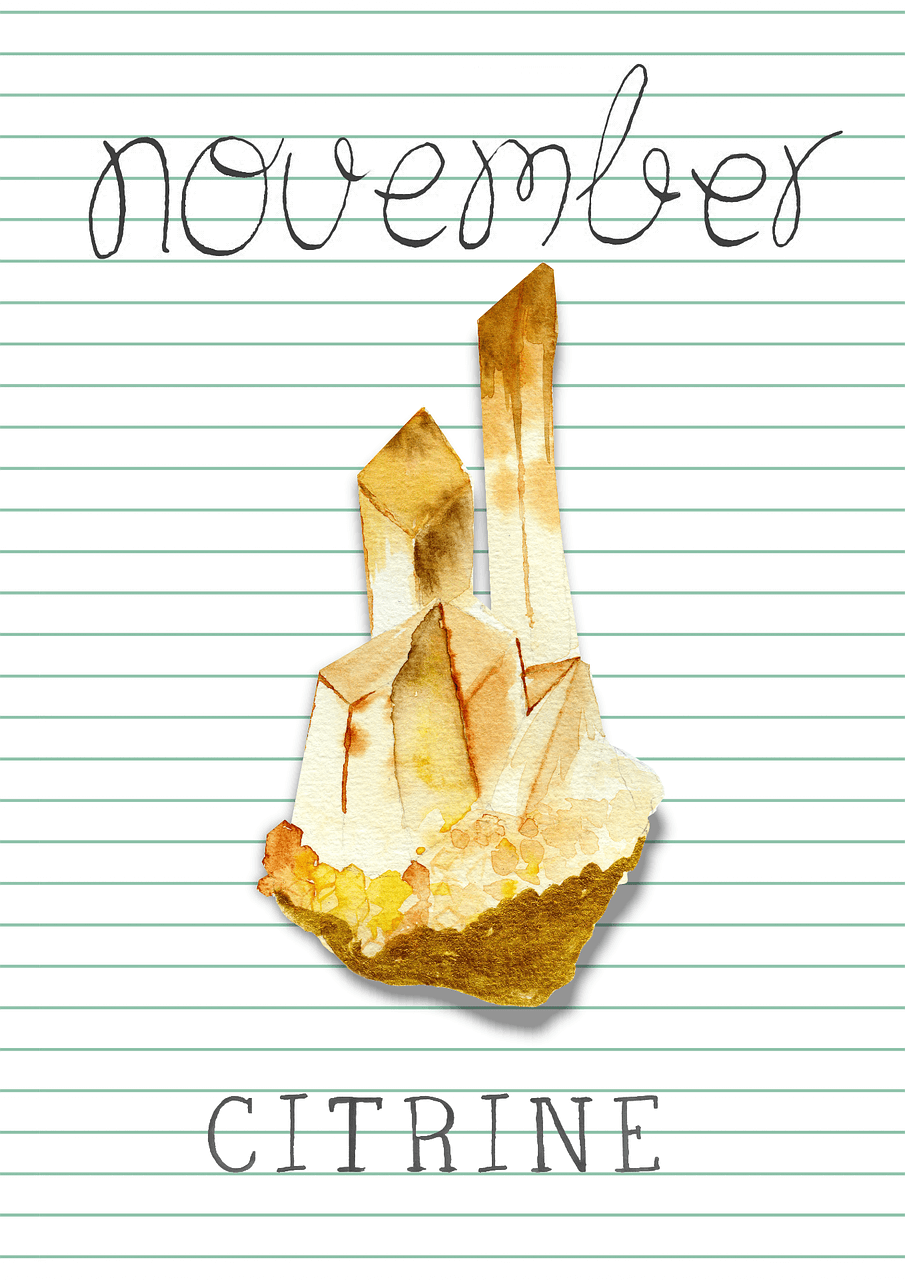
Because of its fresh golden yellow hue, the name citrine derives from the French word citron, meaning lemon. Citrine is part of the quartz family. Its attractive color, durability and affordability make it the top-selling yellow-to-orange gemstone. In the days before modern gemology, it was commonly confused with topaz. Today, it’s an attractive alternative not only for topaz, but also for yellow sapphire.
Natural citrine is actually quite rare. Most citrine on the market today is created by heat treating less desirable pale violet amethyst. This process changes the pale violet color to the attractive yellow citrine is known for.
We currently do not carry jewelry pieces containing citrine gemstones. We do, however, have some with other beautiful yellow and orange gems. Click the link to browse the 100 East Fine Jewelry website for yellow and orange jewelry. Some of our recent designs include pieces featuring yellow and orange sapphires and yellow diamonds, as follows:
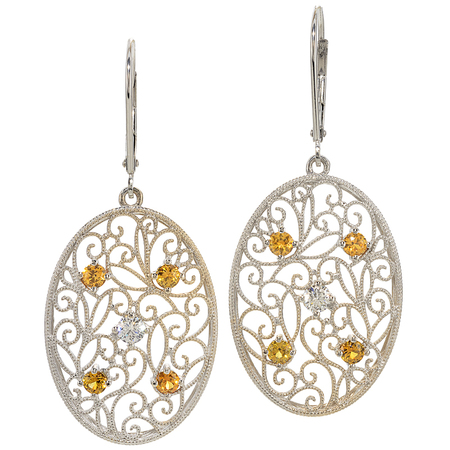
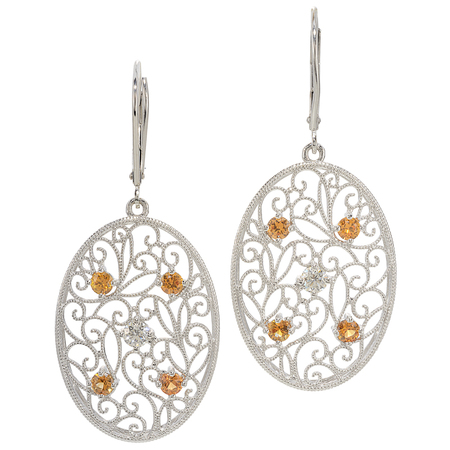
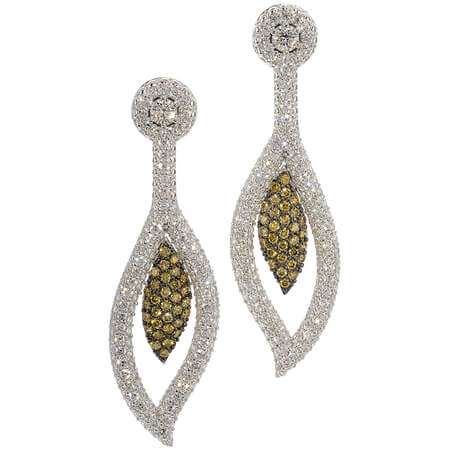
Citrine signifies fidelity and bliss, making it the prefect gemstone to commemorate the 13th wedding anniversary.
History and Lore
Quartz has been used in jewelry for thousands of years. Egyptians used ornately striped agates as talismans. Ancient Greeks carved rock crystal ornaments. Roman pontiffs wore rings set with huge purple amethysts. Even though natural citrine is rare, gems from the Victorian era have surfaced.
In the days before modern gemology, citrine’s range of colors caused it to be confused with topaz. In the 1940s, citrine was enormously popular in jewelry of the era. Its sunny color suited the streamlined style and bold gold of the era. It was often set with ruby, peridot, and aquamarine in colorful brooches, necklaces, and bracelets.
Some of the lore associated with citrine included the belief in ancient times that citrine was treasured as a gift from the sun because of its warm, golden glow. Others carried it as protection against snake venom and evil thoughts. It also was thought to illuminate the sunny disposition of those who wore it. Known as the gemstone of joy and contentment, citrine was believed to inspire optimism, good spirit, warmth and affection.
Use in Jewelry Today
Because of its lemony luster and affordability, citrine is the most popular and frequently purchased yellow gemstone. It perfectly complements warm colors, and offers a striking contrast against black, gray, and blue.
Like all quartz gems, citrine is relatively plentiful, and available in a wide range of sizes and shapes for setting into a variety of jewelry styles. Large gems remain affordable, as price per carat does not rise dramatically for larger sizes. Citrine gemstones up to 20 carats are readily available in jewelry. Even fine citrine has a modest price tag.
Much of the faceted citrine in the market is eye-clean. If present, eye-visible inclusions decrease the stone’s value. Dealers also look for citrine without color zoning.
Modern jewelry designers love to set citrine in yellow gold, either alone or in combination with amethyst, blue topaz, or peridot. Like other quartz gems, citrine is durable and great for everyday wear. Its attractive color, plus the durability and affordability it shares with most other quartzes, makes citrine the top-selling yellow-to-orange gem and an attractive alternative to topaz and yellow sapphire.
Despite its durability, we believe all your gemstone jewelry is best cleaned with warm, soapy water and a soft brush. We consider this a single, safe method to use for cleaning all gemstone jewelry. For additional details, please read our blog; Cleaning Fine Gemstone Jewelry. To learn about caring for all your fine jewelry, please read our blog; Caring for Fine Gemstone Jewelry.
Color Characteristics and Treatments
Citrine’s color ranges from pale yellow to golden honey to brownish orange. Vivid yellows, reddish oranges, and earth tones are popular with consumers. Saturated yellow to reddish orange color citrine free of brownish tints is considered the finest material. However, the contemporary market’s most popular shade is an earthy hue, a deep brownish or reddish orange.
In Bolivia, amethyst and citrine colors occur together in the same crystal, resulting in a gemstone known as ametrine.
Trace amounts of iron in citrine’s crystal structure is responsible for its yellow-to-orange color. Natural citrine is rare, with most of the citrine in today’s market the result of heat treatment. Some undesirable pale violet amethyst undergoes a controlled heating process which changes its color to attractive yellow. The original hue of the amethyst starting material determines the richness of the resulting citrine’s yellow. Also, brown-toned citrine is heat-treated to elicit a vibrant yellow-orange hue. Heat treatment is permanent, and will last for the life of the gemstone.
Other potential citrine treatments besides heat treating can include filling surface-reaching fractures with resin or glass. This kind of treatment is, however, less prevalent than heat treatment. As with all gemstones, any treatments should be disclosed to potential buyers.
Natural gem-quality quartz is plentiful. Despite this, researchers developed a way to synthesize gem-quality quartz because of its key role in technology. These are: (1) its ability to generate electric current when placed under pressure and (2) piezoelectricity, meaning its ability to vibrate at a constant frequency when subjected to alternating current. Piezoelectricity makes it attractive for use in watches, clocks, communications equipment, filters, and oscillators.The first synthetic quartz appeared in laboratories in the 1890s, but it wasn’t until World War II that synthetic quartz was widely commercially available. Eventually, some lab-grown amethyst and other synthetic quartz varieties found their way into jewelry.
Formation, Mining and Cutting
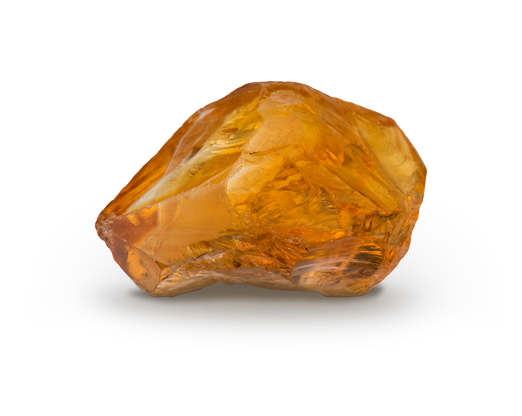
Citrine Crystal - Image Courtesy of GIA
Three of the most popular transparent gem-quality quartz varieties - amethyst, citrine and smoky quartz - all start out as large crystals. Giant hollow crystal-lined amethyst geodes from areas like Brazil are often heated to become giant citrine “cathedrals.” Top sources for natural citrine (not heat treated amethyst) are Bolivia, Spain, Madagascar, Mexico and Uraguay. Brazil is the major source of the amethyst, which when heat-treated, becomes citrine.
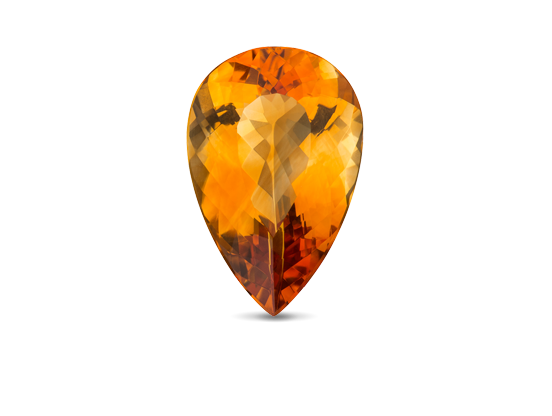
Citrine Gemstone - Image Courtesy of GIA
Citrine crystals occur in a wide range of sizes, and polished gemstones up to 20 carats are readily available for use in jewelry. Citrine might be carved, custom-cut, or calibrated for jewelry use. Although citrine is available in standard shapes and sizes, many high-end jewelry designers and gem carvers have fashioned the warm yellow gem into unusual cuts for jewelry and carvings.
Famous Citrines
Jolie Citrine Necklace– This necklace features 64 graduated bezel-set cushion cut citrine gems highlighted by a 177.11-carat pear-shaped citrine drop. The stones are set in 18 kt yellow gold. The necklace was donated to Smithsonian’s National Gem Collection in 2015 by Angelina Jolie. The piece is from the Style of Jolie jewelry collections, a collaboration between her and distinguished American jewelry designer, Robert Procop.
Credit American Gem Trade Association and Gemological Institute of America.
